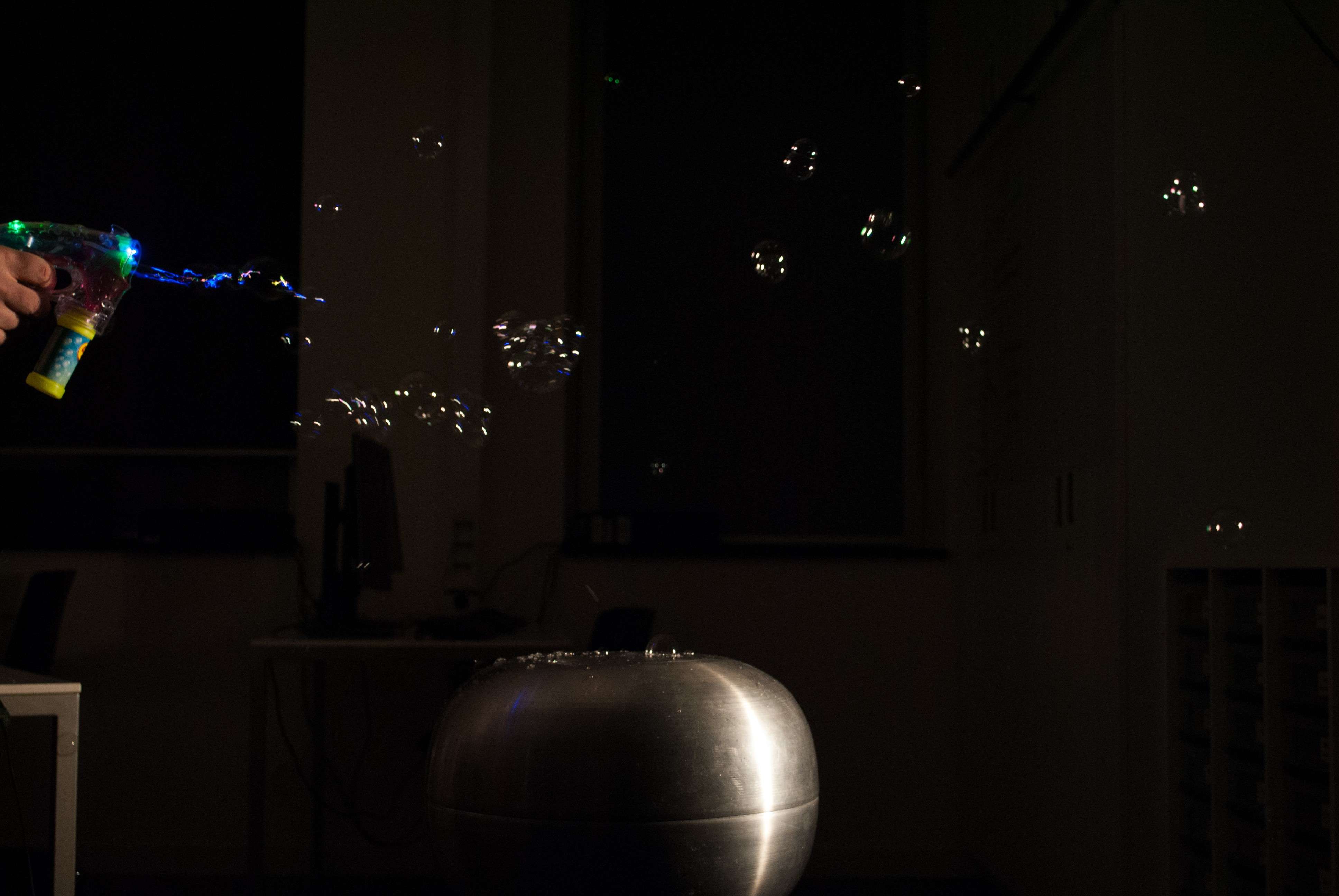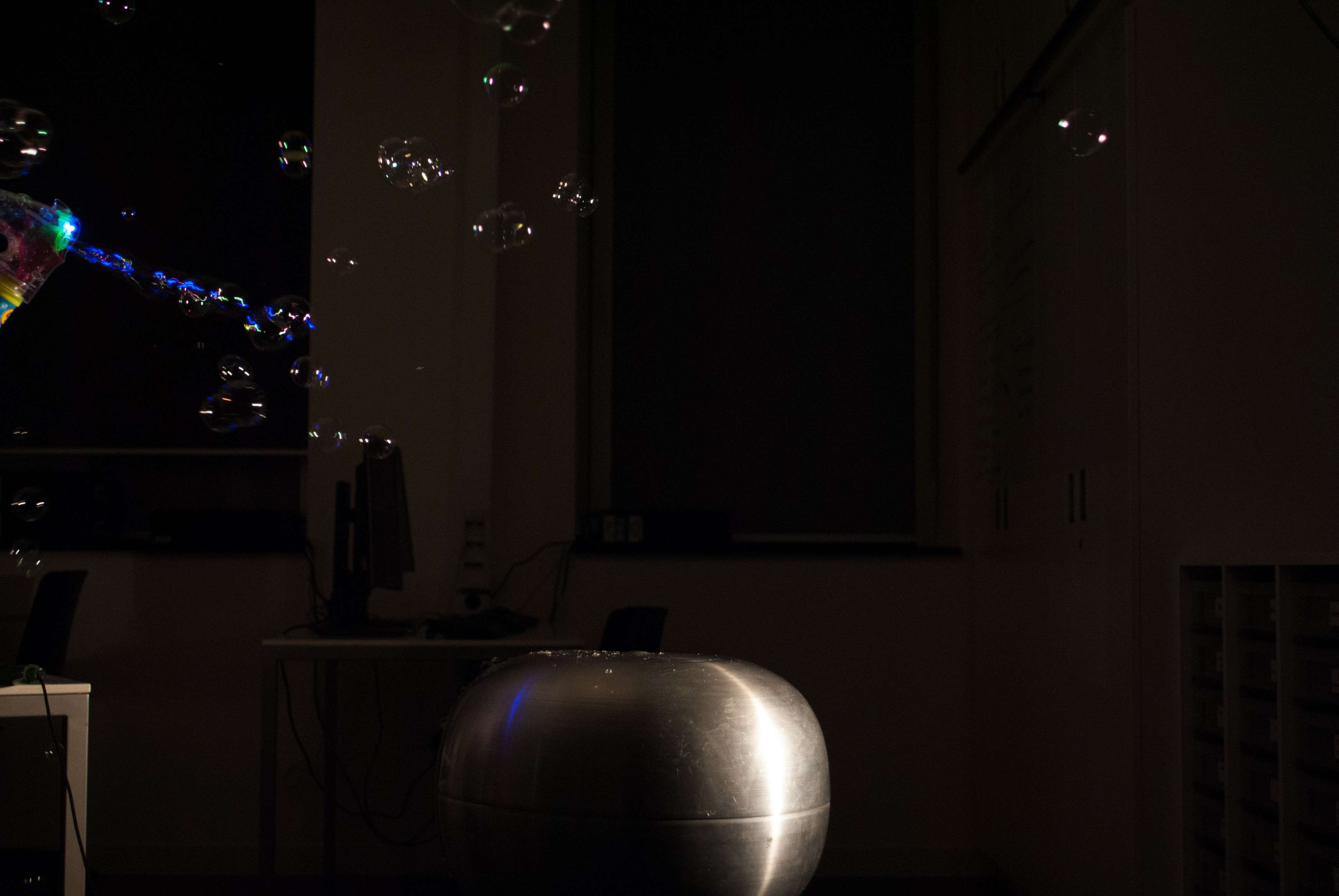14.2. Does Van de Graaff not like a shower?#
Testing statements about electrostatics with a Van de Graaff generator and soap bubbles
| Author: | Wouter Spaan |
| Time: | 15 minutes |
| Age group: | 15 - 18 |
| Concepts: | Charge, electrostatic induction, Coulomb force |

Fig. 14.3 The soap bubble gun and the Van de Graaff generator. In this picture, most bubbles move away from the generator.#
Introduction#
The demonstration of the interaction of Van de Graaff generator with soap bubbles is well-known. In the version described below, our focus is on the development of reasoning skills.
Equipment#
Van de Graaff generator
Soap bubble gun
Camera
Preparation#
For the best visibility, the bubbles should be blown from above to the Van de Graaf generator. Try this out.
Procedure#
Blow the bubbles from above to the Van de Graaff generator (or let a student do this). Ask the students to write down their observations. You will probably get remarks such as ‘the bubbles move away from the generator’. A good observer may have seen that initially the bubbles are moving towards the generator.

Fig. 14.4 The bubbles on the left move towards the Van de Graaff generator, while the bubbles on the right move away from the generator. How is that possible?#
Then you start the process of developing explanations and testing these using (better) observations. The concept cartoon in Figure 14.5 can be helpful as a start. It is important to determine what (observable) consequences each of the proposed explanations has. One can look for these in the experiment and help decide which explanation is the best one:
The bubbles are neutral (carry no net charge) throughout the process: the bubbles will move towards the Van de Graaff generator just like small pieces of paper.
The bubbles are charged from the start: depending on the charge of the bubbles they will move towards the generator or away from it.
The bubbles get charged on the way: the bubbles will change their behavior halfway. First they move towards the generator (as in explanation 1) and then their behavior depends on the charge of the bubbles (as in explanation 2).

Fig. 14.5 The concept cartoon can be used to start the discussion.#
You can record the experiment on video and play it on a screen. Using the recording, students can improve their own observations and then discuss which explanation best fits the observations. It is helpful to play it half speed, making it clear that the bubbles initially move towards the Van de Graaff generator, only to turn around and move away eventually. It can be seen that some bubbles even move away from each other. Obviously, explanation number 3 (the bubbles acquire charge along the way) is the most likely conclusion, although some students will persevere their own opinion.
For a correct explanation, it is important to focus on the moment the bubbles change their behavior, since there is no explanation to the crucial question how these bubbles get charged yet. It turns out the bubbles change their behavior just after one of them hits the generator and pops.
Finally, it is important to evaluate the process of doing inquiry. Starting with a research question, we developed possible explanations (hypotheses) and formulated observable consequences (predictions) which would be the consequence of a correct explanation. Using other techniques we verified which of our prediction, and therefor explanation is the right one.
Tip
There are more ways to work on research skills using this demonstration:
If the students write down their observations, then you can pay attention to the objective formulation of these observations. For example, what is the difference between ‘the bubbles are attracted by the sphere’ and ‘the bubbles move towards the sphere’? Is it important to distinguish between these two types of sentences?
You can discuss the difference between a hypothesis and a prediction. A hypothesis is independent of the experiment, the prediction is dependent on the set-up of the experiment. One possible hypothesis is ‘the bubbles are negatively charged from the start’, a potential corresponding prediction is ‘the bubbles will move away from the negatively charged Van de Graaff generator’.
Physics background#
Initially, the bubbles are attracted by the Van de Graaff generator through electrostatic induction: the dipolar water molecules align with the electric field of the generator. Because the field is inhomogeneous, there is an attracting force towards the charged sphere of the generator. The bubbles have no net charge yet!
When the first bubble touches the generator sphere, it will receive the same type of charge as the generator and it will burst. The resulting droplets have the same charge and are thus repelled by the sphere and hit the bubbles that are still on their way to the generator. These bubbles get charged resulting in a repulsive force, consequently, the bubbles will start moving away from the generator. A new series of bubbles will initially be attracted again and so on.
